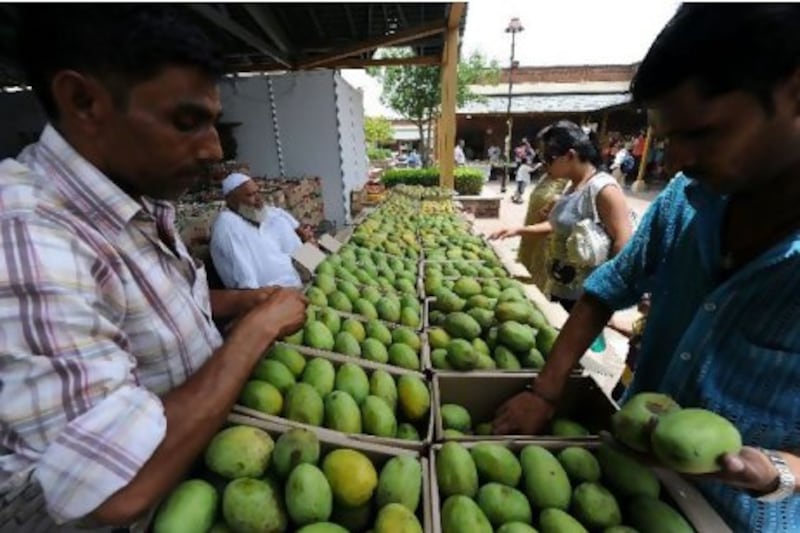NEW DELHI // Mango enthusiasts descended on the capital this weekend to show their appreciation for India's favourite fruit.
With more than 500 varieties on display, the crowds touched, smelled and devoured their way through the 23rd annual Mango Festival.
India grows more than half of the 1,300 varieties of mangoes grown worldwide. They come in all shapes, sizes and colours, but it is the taste that causes the most dispute among gourmands. From smell and tartness to the texture of the pulp, the foodies were relentless in their pursuit of finding a favourite this season.
One visitor to the festival, Sanchita Sharma, said: "I like it with a hint of sourness. But I can't take it if the pulp is too mushy. All this is just luck. Finding the perfect mango to eat every summer is hard work."
The mango growers would argue that luck has nothing to do with it. Mostly from the Indian state of Uttar Pradesh, they are vehement that the art of growing and harvesting the perfect mango has been perfected by science.
In Tafzeel Ahmed's orchards in Saharanpur, the more delicate varieties of mangoes are picked by hand. The mangoes are then placed at an angle for two hours to drain the sap, which Mr Ahmed said contains acids "that are not good for a man's throat".
Depending on which international market the fruit will travel to - and $50 million of mangoes were sold abroad in 2009-10 - they undergo different processes to meet international export standards and kill potential fungi, weevils and fruit fly larvae.
One thing the farmers fret about, and something science cannot yet control, is the weather. For example, a violent thunderstorm may leave grey, patchy spots on the fruit while it is still ripening on the tree.
"If it is not looking good, it is not exportable," Mr Ahmed said. "The foreigners get afraid when they see any kind of marks on the mango's skin."
India contributes to nearly 50 per cent of the world's demand for mangoes, according to a statement released by Delhi tourism board. It said that India's mango exports are expected to rise to 70,000 tonnes this year, up by about 5,000 tonnes from last year. The biggest markets are the Middle East, Eastern Europe and Japan.
Mr Ahmed, whose orchards supply mangoes to the Uttar Pradesh government's Nawab (king) brand, said most of the fruit he harvests is destined for the UAE, followed by Japan and Singapore.
"I remember the first time I received an order in 2004 for a shipment to Dubai," Mr Ahmed said. "The Indian government's reputation was on the line. We had to harvest mangoes at night, with torches, because a last-minute order had come in."
It was the same year that Mr Ahmed quit working as a banker to turn what had previously been a hobby into a full-time business. His parents had left him 70 acres of land with a stipulation that he grow only mango trees. "I remember that year because we wasted a lot of mangoes. I had no idea of how to properly harvest them," he said. "Now I can tell you how to hold a mango so you won't bruise it."
But this year's extreme weather has Mr Ahmed worried. Last year's harsh winter meant that a lot of mango blossoms, which bud in December, died. In June, premature thunderstorms that signal the arrival of monsoon season also caused a lot of damage to the fruit, knocking them off the branches.
Mr Ahmed was not the only grower affected by the weather. On Bajmi Kareemullah's farm in Malihabad in Uttar Pradesh, the storms played havoc with the harvests. "Usually when we come to the festival, the hallways are packed with baskets of fruit. This year we barely managed to retain even display samples," Mr Kareemullah said. "We are really worried about exports. Even the Indian market is suffering."
Mr Kareemullah, whose family has been in the mango-growing business for 300 years, won two titles at the festival, including for the heaviest fruit, at 2.75 kilograms, and the best-tasting mixed variety. Mr Kareemullah said his father, Haji, has grown more than 250 varieties of mangoes on the same tree by using the grafting method, where a branch from one mango variety is spliced and grown from the rootstock of another.
Despite the lack of fruit, his booth at the festival proved to be a favourite thanks to the saplings he was selling. Ashok Kumar, 57, a businessman from Delhi, bought six young trees for a property he had recently bought outside the city.
"This is a better investment than watching the prices of mangoes go up every year," Mr Kumar said. "I am a patient man. I can wait to grow and eat my own mangoes." A mango tree takes up to three years to bear fruit.
Mr Kareemullah's family likes to name their mango hybrids after Indian cricket stars (Sachin, for Sachin Tendulkar) and Bollywood celebrities (Aishwarya, for Aishwarya Rai Bachchan).
Sarjit Singh, 12, wasn't interested in the names of the fruits he was scoffing - he just wanted to sample as many as possible. He thought he had tried at least five different varieties in two hours.
"There are so many, many different kinds here and I want to taste all them," he said. "I badly want more mangoes."





